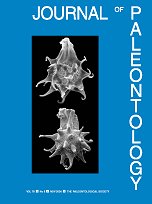Many bivalves and brachiopods possess multilayered shells. In one such bivalve, Mytiloides ipuanus (Wellman, 1959) (Inoceramidae), the mineralized shell comprises an outer prismatic calcite layer and an inner nacreous aragonite layer. Each of the three shell surfaces—the external, internal, and shell layers' interface—has a distinct sculpture. Pronounced costae on the shell interface are “cryptic” in the sense that, in life, they would have been barely expressed on the internal surface and only expressed as comparatively weak, broad, rounded costae on the external surface. In fossil specimens, depending on the timing of shell dissolution relative to compaction and lithification, any of these sculptures may be preserved and combined in various ways on simple or composite surfaces/ molds. Many of the resulting specimens appear to be morphologically quite distinct from each other. The form and distribution of particular “taphomorphs,” however, can be predicted from a knowledge of shell mineralogy and taphofacies. The different sculptures present on the three shell surfaces, and their wide range of taphonomic expressions, had not been recognized previously, resulting in the erection of three nominal taxa for this single species, based on different taphomorphs. It is not clear whether similar problems remain undetected in other multi-shell-layered invertebrate fossil groups.
How to translate text using browser tools
1 November 2004
SHELL COMPOSITION, CRYPTIC COSTAE, COMPLEX COMPOSITE MOLDS, AND TAPHONOMIC CHICANERY IN MYTILOIDES (INOCERAMIDAE, BIVALVIA)
JAMES S. CRAMPTON
ACCESS THE FULL ARTICLE

Journal of Paleontology
Vol. 78 • No. 6
November 2004
Vol. 78 • No. 6
November 2004




